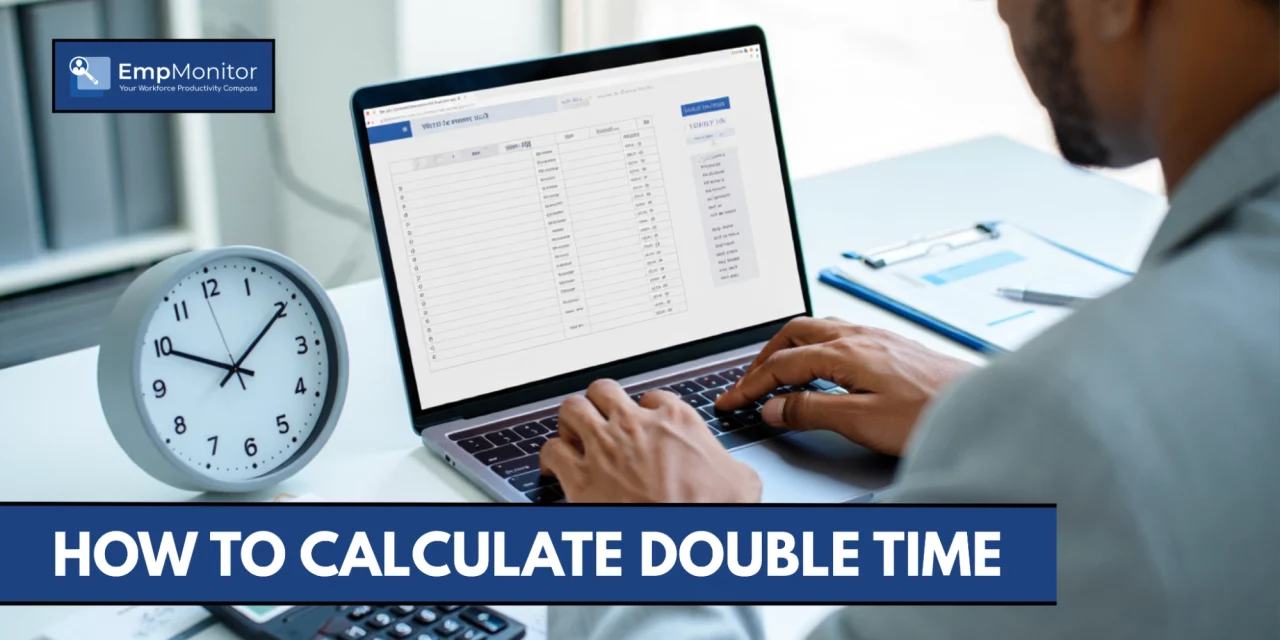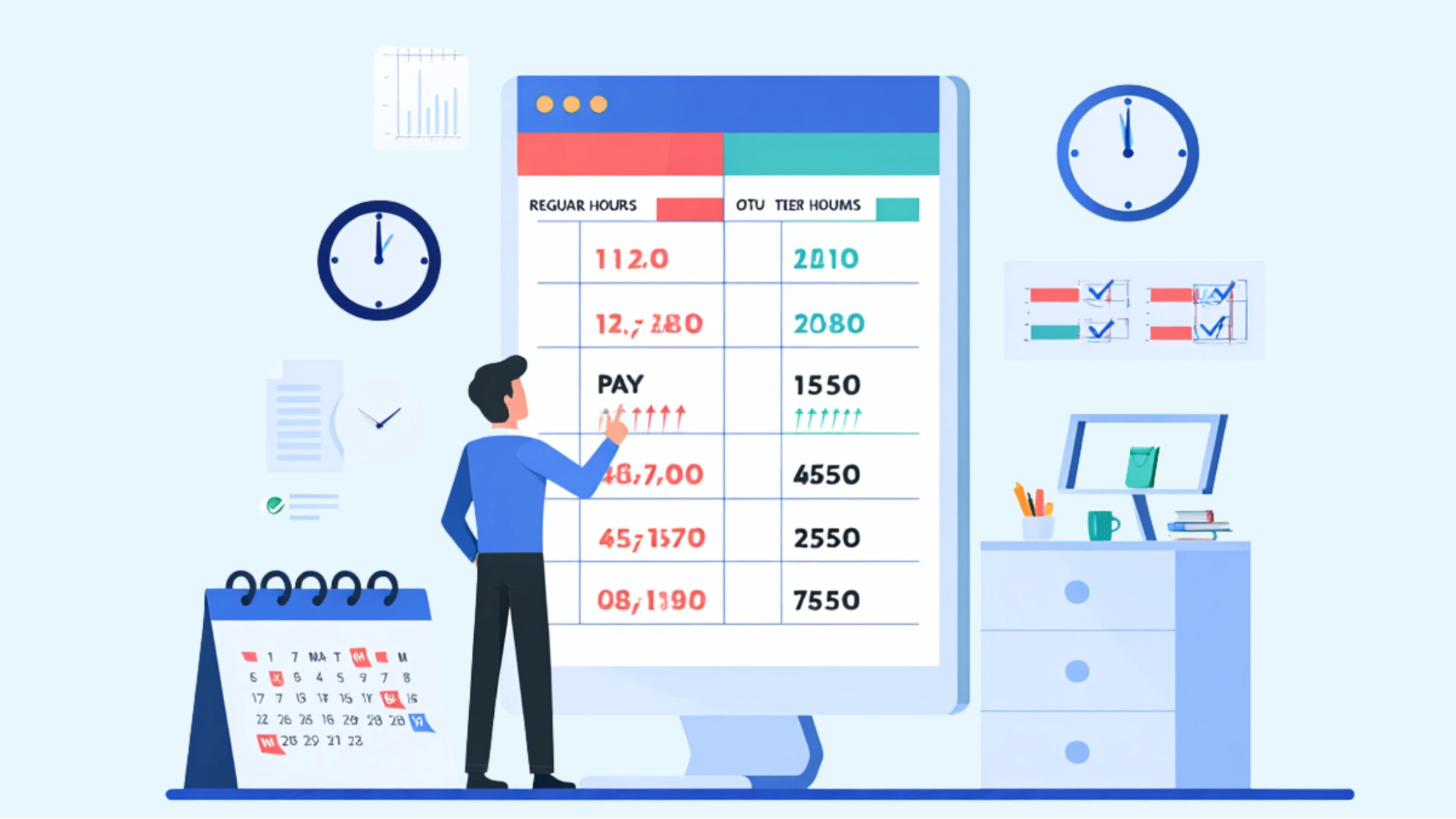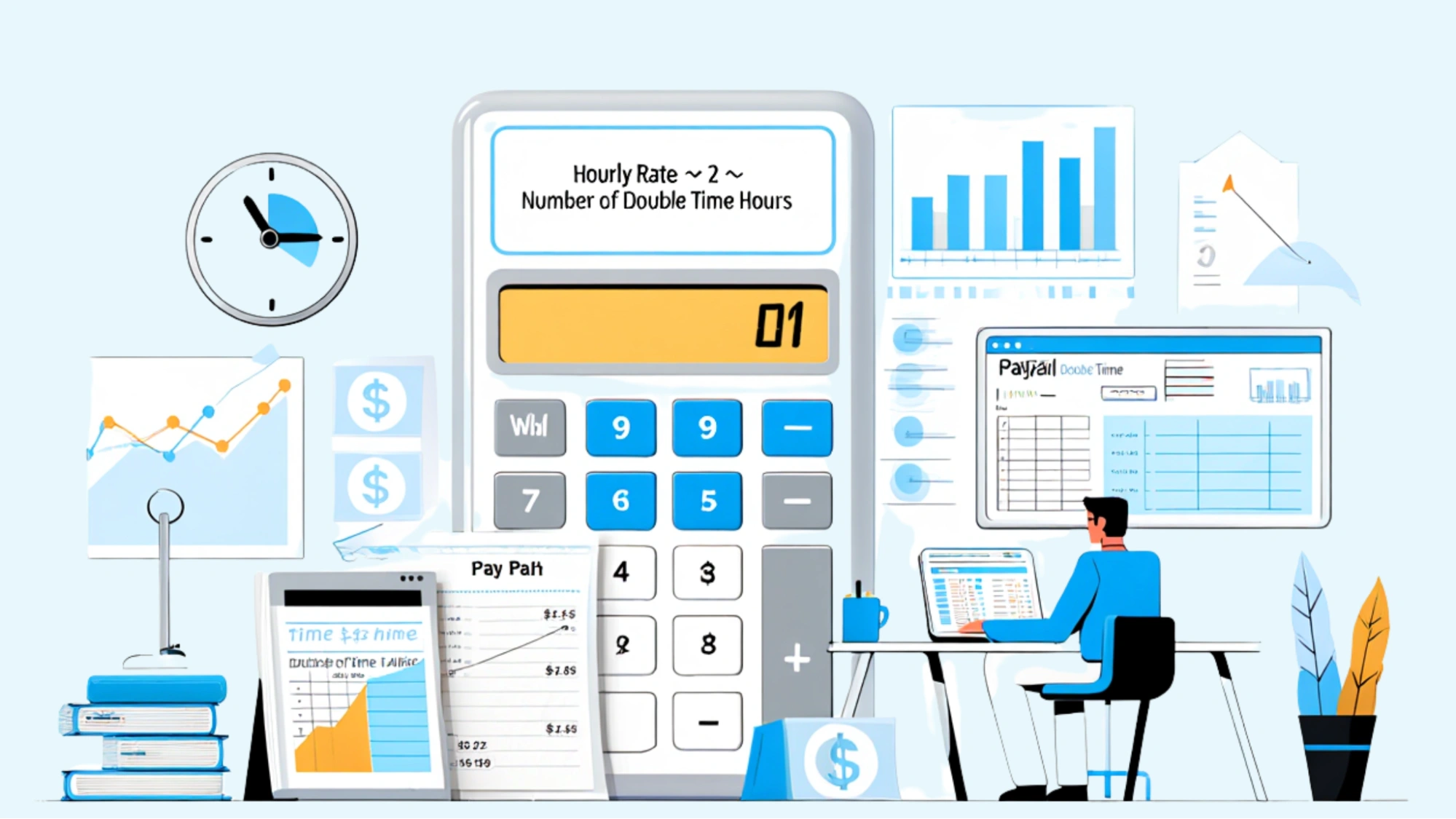Calculating double time pay can feel confusing, especially if you are new to hourly work or managing payroll. Knowing how to calculate double time correctly is important for both employees and employers. It ensures workers get paid fairly for extra hours, and businesses stay compliant with labour rules.
In this guide, we will break down how to calculate double time pay, how it works, and walk you through simple steps to calculate it for hourly employees.
By the end, you will have a clear understanding and be able to handle double time calculations without any guesswork.
Tap to listen!
What Is Double Time Pay?
Double time pay is exactly what it sounds like: you earn twice your regular hourly rate for certain hours worked. It’s different from overtime, which usually pays time and a half.
Double time is often offered for working on holidays, weekends, or when you exceed a daily or weekly hour threshold set by law or company policy.
For example, if your normal hourly rate is $20, working a double time hour would pay $40. Employers use double time as a way to compensate employees for extra effort or inconvenient hours.
Understanding when and how double time applies is key to making sure you are paid correctly and that businesses follow labour rules.
How Does Double Time Work?
Double time kicks in under specific conditions, usually set by company policy or labour laws.
Common situations include working on holidays, weekends, or hours that go beyond a daily or weekly limit. Some states or countries have their own rules, so eligibility can vary depending on where you work.
It is important to know that double time is different from overtime. Overtime typically pays one and a half times your regular rate, while knowing how to calculate double time ensures you receive twice your regular rate for eligible hours. In some cases, double time can overlap with overtime, such as working a holiday that also exceeds your normal weekly hours.
For employers, tracking double time hours carefully is crucial to staying compliant. For employees, understanding how it works ensures you are getting the pay you are owed for extra or unusual hours.
You might also like:
How Do You Calculate Double Time? (Step-by-Step Guide)
Calculating double time is simpler than it sounds once you know the formula. Here’s how to do it for hourly employees:
Step 1: Identify your regular hourly rate
This is the pay you normally receive per hour. For example, $20 per hour.
Step 2: Determine which hours qualify for double time
Check your company policy or local labour laws. Common examples include holidays, weekends, or hours exceeding daily or weekly thresholds.
Step 3: Apply the double time formula
Double Time Pay = Hourly Rate × 2 × Number of Double Time Hours
Example 1:
If your regular rate is $20 and you work 3 double time hours, the calculation is:
$20 × 2 × 3 = $120
Example 2 (Holiday + Overtime):
If you normally earn $20/hour, work 2 overtime hours at $30/hour (time-and-a-half), and 2 holiday hours at double time:
- Overtime pay: $30 × 2 = $60
- Double time pay: $40 × 2 = $80
- Total extra pay = $140
Step 4: Add any applicable bonuses
Some companies adjust your hourly rate to include nondiscretionary bonuses before calculating double time. Always confirm your payroll rules.
Following these steps ensures that double time is calculated accurately, so employees get the pay they deserve and employers stay compliant.
Examples Of How To Calculate Double Time Pay For Hourly Employees
How to calculate double time pay is compensation at twice an employee’s regular hourly rate, typically for hours worked beyond a certain threshold (e.g., over 12 hours in a day or during specific overtime conditions, depending on labour laws or company policies). Below are examples to illustrate how to calculate double time pay.
Example 1: Basic Double Time for Overtime Hours
An employee earns $20 per hour and works 14 hours a day. The company policy states that hours beyond 12 are paid at double time.
- Regular hours (first 12): 12 × $20 = $240
- Double time hours (13–14): 2 × ($20 × 2) = 2 × $40 = $80
- Total pay for the day: $240 + $80 = $320
Example 2: Double Time After Overtime Threshold
An employee earns $15 per hour and works 50 hours a week. The first 40 hours are regular pay, hours 41–48 are time-and-a-half, and hours beyond 48 are double time.
- Regular hours (first 40): 40 × $15 = $600
- Time-and-a-half hours (41–48): 8 × ($15 × 1.5) = 8 × $22.50 = $180
- Double time hours (49–50): 2 × ($15 × 2) = 2 × $30 = $60
- Total weekly pay: $600 + $180 + $60 = $840
Example 3: Double Time for Holiday Work
An employee earns $25 per hour and works 8 hours on a holiday, where company policy mandates double time for all holiday hours.
- Double time hours: 8 × ($25 × 2) = 8 × $50 = $400
- Total pay for the holiday: $400
Key Points to Remember
- Double time rules vary depending on labour laws or company policies. Check local regulations.
- Formula: Double time pay = Hours worked × (Regular hourly rate × 2)
- Taxes and deductions apply the same as regular pay.
These examples show how to calculate double time pay works in different scenarios, making it easier to calculate and apply it to your own hours.
Double Time Pay Vs Overtime Pay: Key Differences
Double time and overtime are related but not the same.
Understanding the difference helps both employees and employers avoid mistakes.
Overtime Pay
- Typically pays 1.5 times your regular rate for hours beyond the standard workweek (usually over 40 hours in the U.S.).
- Applies to most hourly employees, depending on labour laws and company policy.
Double Time Pay
- Pays 2 times your regular rate.
- Usually applies to specific situations, like holidays, weekends, or hours exceeding a daily or weekly threshold set by law or company policy.
- Can sometimes stack on top of overtime if both conditions are met (for example, a holiday that also exceeds the weekly hour limit).
Key Takeaways
- Overtime is more common; double time is reserved for special situations.
- Both are designed to compensate employees fairly for extra or inconvenient hours.
- Knowing the difference ensures accurate payroll and compliance with labour laws.
Do Salaried Employees Get Double Time Pay?
For most salaried employees, double time does not usually apply.
Salaried workers are often considered exempt, meaning they receive a fixed salary regardless of hours worked. This includes many managers, professionals, and executives.
However, there are exceptions. Non-exempt salaried employees, those whose roles qualify under labour laws for overtime, can earn double time if they meet the conditions set by company policy or state regulations. For example, a non-exempt salaried worker who works on a recognised holiday or exceeds daily hour limits may be eligible for double time.
Key points to remember:
- Always check whether a salaried employee is exempt or non-exempt.
- Company policies and local labour laws determine eligibility.
- Clear communication from HR helps prevent confusion about pay.
Understanding this distinction ensures that salaried employees are treated fairly and employers remain compliant.
Common Mistakes Employers Make In Double Time Pay Calculation
Even experienced employers can make errors when calculating double time. Avoiding these mistakes ensures employees are paid correctly and keeps your business compliant with labour laws.
Common mistakes include:
- Misclassifying employees: Treating non-exempt employees as exempt can lead to mistakes in how to calculate double time, resulting in underpaid hours.
- Forgetting holiday or weekend rules: Double time often applies for specific days or shifts, and failing to account for them can underpay employees.
- Incorrect payroll tracking: Not accurately recording hours worked, overtime, or double time hours can lead to calculation errors.
- Overlooking bonuses: Some policies require including nondiscretionary bonuses in the hourly rate before calculating double time, ensuring that employees are fairly compensated for all forms of guaranteed pay when overtime rules apply.
- Mixing overtime and double time incorrectly: Understanding when each applies is key to avoiding overpayment or underpayment.
Careful tracking, clear policies, and regular audits can prevent these common pitfalls and ensure employees are compensated fairly.
Tools To Help Calculate Double Time Accurately
Calculating double time pay does not have to be complicated. With the right tools, you can automate the process and ensure accuracy. One such tool is EmpMonitor, a comprehensive employee monitoring and time tracking software.
What Is EmpMonitor?
EmpMonitor is a cloud-based employee monitoring and time tracking software designed to help businesses track work hours, monitor productivity, manage remote teams, and ensure compliance with company policies. It provides real-time dashboards, automatic timesheet tracking, activity monitoring, project management, and automated reporting to streamline payroll, including tasks like calculating double-time pay accurately.
EmpMonitor Features:
- Automatic Timesheet Tracking: EmpMonitor automatically tracks employees’ work hours, reducing manual errors and ensuring accurate time logs. This feature is particularly useful for calculating double time pay based on actual hours worked.
- Real-Time Activity Monitoring: The software provides real-time insights into employee activities, including applications and websites used, helping managers identify when double time rates should apply.
- Idle Time Detection: EmpMonitor detects periods of inactivity, ensuring that only productive hours are counted towards double time calculations.
- Project Time Tracking: Assign tasks to specific projects and track the time spent on each, facilitating accurate billing and payroll calculations.
- Billable Hours Tracking: For businesses that bill clients based on hours worked, EmpMonitor helps track billable hours, including those at double time rates.
By integrating EmpMonitor into your workflow, you can streamline how to calculate double time, ensuring accurate pay and compliance with labour laws and company policies.
Conclusion
Calculating double time pay does not have to be complicated. By understanding what double time is, knowing how it works, and learning how to calculate double time, both employees and employers can ensure fair and accurate pay.
Remember to check company policies and local labour laws, especially for holidays, overtime thresholds, or state-specific rules. Tools like EmpMonitor can make tracking hours and calculating double time much easier, helping avoid errors and saving time.
With the right approach and tools, handling double time pay becomes straightforward, ensuring everyone gets what they are owed.
FAQs About Double Time Pay
Here are some common questions employees and employers have about double time pay:
Is double time required by law?
Not always. Double time rules depend on labour laws in your state or country and your company’s policies. Some states, like California, require double time after a certain number of hours worked in a day.
How does double time work during holidays?
If company policy or local law mandates it, any hours worked on a holiday can be paid at double the regular rate.
Do part-time employees get double time?
Yes, if they meet the eligibility criteria set by law or company policy. Double time is calculated the same way as for full-time employees.
Can overtime and double time overlap?
In some cases, yes. For example, if an employee works a holiday that also pushes their weekly hours past the overtime threshold, both calculations may apply.
How do bonuses affect double time pay?
Some policies require including nondiscretionary bonuses in the hourly rate before calculating double time. Always check your company policy.
Can part-time or temporary employees earn double time?
Yes. If part-time or temporary employees meet the eligibility criteria set by labour laws or company policy, they can receive double-time pay for qualifying hours. The calculation works the same as for full-time employees.
How should employers document double-time hours?
Employers should keep accurate records of hours worked, including regular, overtime, and double-time hours. Using tools like EmpMonitor or detailed timesheets helps ensure correct payroll and compliance with labour regulations.



















